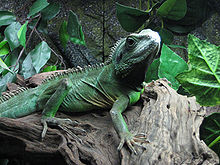Green water dragon
| Green water dragon | ||||||||||||
|---|---|---|---|---|---|---|---|---|---|---|---|---|

Green water dragon ( Physignathus cocincinus ) |
||||||||||||
| Systematics | ||||||||||||
|
||||||||||||
| Scientific name | ||||||||||||
| Physignathus cocincinus | ||||||||||||
| Cuvier , 1829 |
The Green Water Dragon ( Physignathus cocincinus ) occasionally, also Green Water Dragon or Burmese Wasseragame called, is a Echseart from the family of Agamas (Agamidae). Described Physignathus cocincinus first time in 1829 by Cuvier . The green water dragon is called. It is currently the only legitimate species in the genus of water dragons ( Physignathus ).
description
Hatchlings measure 13 to 15 centimeters in length from the head to the tip of the tail, of which the head-torso length has a proportion of five to seven centimeters. Females then grow to a total length of 80 centimeters (with a head-trunk length of 20-25 cm), while males grow to a length of up to one meter (of which 25-30 cm head-trunk length). The leaf-, blue- or olive-green basic color (shortly before the moulting also brown) is interrupted by a few cream-colored bands. The tail has dark, broad stripes at any age, which become wider towards the tip of the tail; the tip of the tail is often black. In addition, the tail is flattened laterally like a paddle, which allows the water dragon to swim very quickly. A back crest stretches from the neck to behind the base of the tail.
Occurrence
Distribution area is Southeast Asia, where the species occurs from South China to Vietnam . There it lives in the humid, tropical lowland rainforest. They are most commonly found in densely vegetated, flowing or standing water.
Behavior and social structure
Water dragons are very shy and often react in a panic to threats. Since they usually sunbathe on branches above bodies of water, such as sailing lizards and iguanas , they let themselves fall into the water from sometimes great heights even if there are minor signs of danger, which enables a quick escape. Such behaviors are typical of water dragons . The animals love the water and have very good swimming and diving skills. Green water dragons live in small family groups and groups with one male and one to three females.
Young animals largely eat insects, while adult specimens eat rodents, birds, fish, large insects and other invertebrates in addition to a vegetarian diet. The water dragons owe the fact that birds are also part of the prey spectrum to their good climbing ability. They are also amazingly nimble and agile in the water, which makes them very successful fish hunters.
Reproduction
The female is courted by the male. This can also lead to chases. As long as the female is ready to mate, it remains and the male sets the so-called "neck bite". It bites the female's neck crest. Then the pairing follows. A while later, the female builds a nesting pit that is about 10 to 20 centimeters deep and lays up to 16 eggs, from which the young hatch after 67 to 101 days, depending on the external temperature conditions.
literature
- Kerstin Franke: keeping and breeding of the green water dragon (Physignathus cocincinus). In: Terraria. Vol. 2, No. 2 = No. 4, 2007, ISSN 1613-1398 , pp. 54-62.
- Heiko Werning : The Green Water Dragon. Physignathus cocincinus. Natur-und-Tier-Verlag, Münster 2004, ISBN 3-937285-32-6 .

